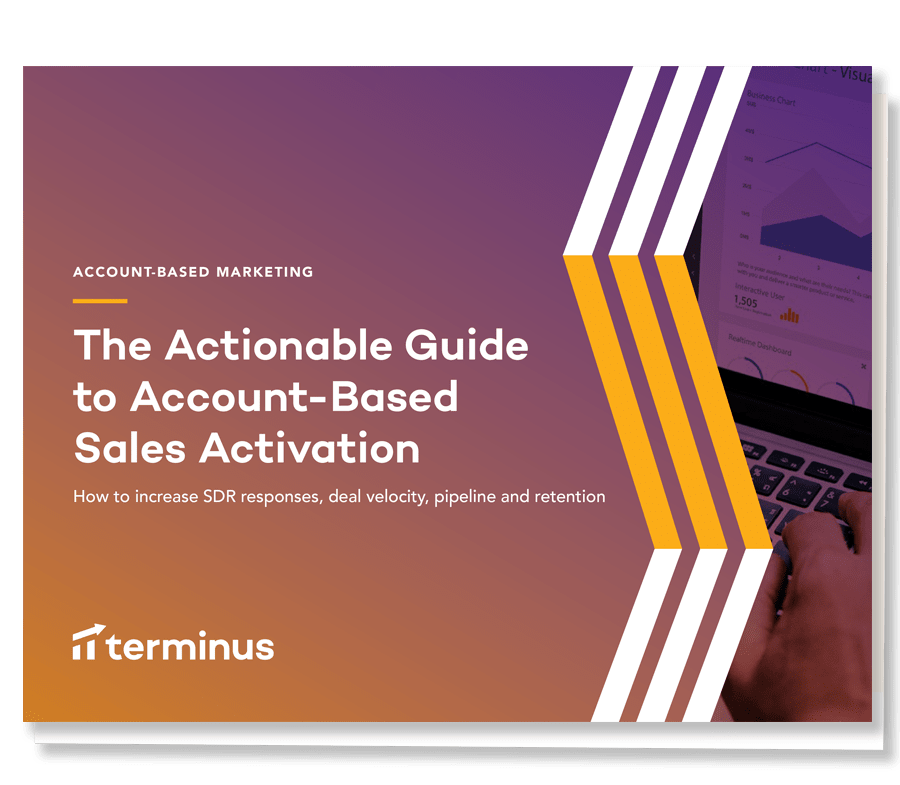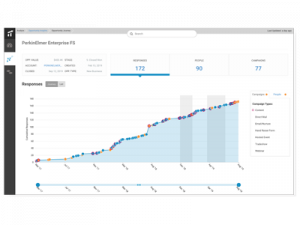The Actionable Guide to Prospecting Leads With Account-Based Marketing
A tactical ebook on how to increase sales development responses, prospect engagement, deal velocity, and pipeline.


The #1 ABM Platformfor Personalized & Efficient Sales Prospecting
Give your sales development team the air cover and data they need to set meetings and progress deals. See how Terminus can help by checking out the sales product feature overview.

Account Based Sales Development: The Sales & Marketing Glue
READ THE BLOG POST
How to Prioritize and Personalize Sales Outreach with Account Engagement Metrics
LEARN MORE
The Science of Sales: An Ideal Number of Accounts for Sales Development to Manage
CHECK IT OUTProspecting Leads
What is prospecting in sales? Well, prospecting in sales is a lot like prospecting gold. Think about the general prospecting meaning: Finding resources. Prospecting leads is similar to prospecting anything else; you need to find leads so that you can start the process for securing them. Another word for prospecting in sales is “lead generation,” but though the two terms are sometimes used interchangeably, they are actually different in emphasis. The importance of prospecting cannot be overestimated. Without prospecting leads, you can’t record sales.
Online prospecting has made the job a lot easier for a lot of marketers. Today, prospecting can be done through content marketing, inbound marketing, email marketing, or outbound marketing. But lead prospecting is as much about technology as it is about strategy.
There are many ways to prospect leads. An individual might email a mailing list, pay for paid advertising leading to a landing page, or invest a lot of time and money into a social media campaign. How the leads are discovered isn’t always the most important part, but rather how the leads are scored. When leads are scored, they are prioritized based on how likely they are to commit. The better the scoring is, the more likely it is that a company will be able to generate significant revenue through their lead prospecting process. If the organization isn’t able to score its leads effectively, sales professionals can’t make the most out of their time.
Today, a lot of online prospecting is automated. Systems are able to automatically generate leads and forward them to a sales team for further commitment. This has made it far easier for sales teams to process and scale.
Prospecting Methods
What are some of the major prospecting methods? There are probably as many prospecting strategies as there are marketers. In the old days, major sales prospecting methods were face-to-face. Salespeople would walk into businesses or homes and try to talk to a decision-maker. Today, B2B prospecting methods are mostly online. An example of a common prospecting method is to look at LinkedIn (either manually or through a software solution) to see changes in the corporate structure of a company. From there, the sales professional can identify someone who might be interested in making changes.
Here are some other common types of prospecting:
- Referral marketing. By encouraging existing customers to refer other customers, you already have a certain level of buy-in. People trust word-of-mouth advertising over all other types of advertising and will therefore trust someone who is referring them more than they would trust your own marketing.
- Content marketing. If you write it, they will come. Develop content for your site such as videos, blogs, and articles, and encourage people to trust your site as an authority. The more they interact with your organization, the more likely they will be to become leads.
- Email marketing. Email marketing is an excellent way to connect one-on-one with people digitally. Through the right digital marketing, an organization is able to reach out to decision-makers directly.
- Networking. Old-fashioned networking is particularly important with high-value sales. While it takes more time to secure someone, you’re more likely to secure larger sales.
These sales prospecting techniques are often used in the process of strategic prospecting. But the prospecting process is unique to every business; companies need to develop their own inbound and outbound prospecting strategy to be really effective.
When it comes to inbound vs outbound prospecting, neither is necessarily better than the other. Prospecting skills and prospecting tactics will focus on both. Those who want to learn more can look at a sales prospecting techniques PDF or inbound prospecting strategy example. Sales prospecting tips can help.
B2B Prospecting Tools
B2B prospecting tools make the process of prospecting far easier. Some top sales prospecting tools include Outreach, SalesLoft, LinkedIn, and Bombora. These span the gamut between very expensive and entirely free. The best B2B prospecting tools available will automate much of the sales process, identifying and scoring leads through data-mining and artificial intelligence. The best prospecting tools 2019 and 2020 are highly advanced, with technology that wasn’t available previously. And some companies may prefer an industry-based solution, such as car sales prospecting tools.
First, let’s look at free sales prospecting tools, like LinkedIn.
LinkedIn is considered a lead prospecting technology today. Individuals can scan through LinkedIn for companies that might be interested in their business. From there, they can connect to people who are decision-makers within the business. So though it isn’t intended as prospecting technology, LinkedIn is one of the most versatile of lead prospecting tools. It doesn’t require any additional sales prospecting software and it can work directly with other solutions.
However, most companies want a more advanced solution such as Terminus. The Terminus lead generation software is able to use advanced algorithms to find, track, and score leads. Through a good sales prospecting system, organizations are able to track their interactions with potential customers, and they can grow to be more effective over time. As an account-based marketing platform, Terminus makes it easier to personalize marketing directly to prospects and customers, leading to higher quality one-on-one interactions. These high-quality one-on-one interactions ultimately mean that accounts feel more compelled to engage and commit.
The better an organization’s technology is, the more accounts a single individual can manage. Sales teams are able to more aggressively scale if they are able to leverage technology, and they can improve upon the relationships that they have with their prospective and current customers. By engaging customers more one-on-one (such as through account-based solutions), they can also improve the branding of their organization. It may take some time for organizations to find the right sales prospecting tools for their sales pipeline, or to find solutions that integrate appropriately with their business’s existing technology.
Lead Generation
Let’s say that in the gold industry, “prospecting” would mean going to a mine and looking for gold. Well, lead generation would be going to other people and finding out whether they have mines that could churn out gold. Lead generation is a lot like prospecting, and the lead generation definition is similar: Looking for sales prospects. Where it differs from ordinary prospecting is that it’s a highly active activity. A lead generation job description is likely to describe finding processes and technology that can be used to actually find leads. Thus, the prospecting vs lead generation difference is that in lead generation, the individual in question is taking an active role in trying to figure out the best way to bring prospects in.
Most organizations engage in prospecting, but lead generation is another level above it. The lead generation meaning has a heavy emphasis on actively creating structures under which the organization is able to better find leads. As the organization becomes better at generating leads, it can then score and engage these leads far more effectively.
What are some examples of lead generation?
Some examples of lead generation include going to seminars and actively courting customers that are interested in products. Another form of lead generation includes sending out coupons to existing or prospective customers to encourage them to make a purchase. These lead generating activities are far less passive than traditional lead prospecting and also more widespread; there’s a process that is being used to generate leads as effectively as possible.
But they also need to be qualified. Why is lead qualification important? Without lead qualification responsibilities being met, the leads going through may not be ready to convert. Lead qualification techniques ensure that the leads are appropriately scored.
Lead Generation Strategies
Companies everywhere want to improve their lead generation. There are lead generation strategies that organizations can push into their lead generation process to improve efficiency and streamline their operations. Here are a few strategies:
- Gating content. Gating content is a form of aggressive lead qualification. Only those who get through the content gate are going to be generated as leads, and therefore these leads are already going to be displaying significant interest and buy-in. This is an automated lead qualification and a great inbound prospecting strategy because sales staff will not waste their time on individuals who are not truly interested in the products or services.
- Buying ad space for content. Paid ads are still one of the most effective methods of sales prospecting. But during lead generation, it’s important to target the content effectively. Organizations should identify their buyer personas and target them by buying advertising in the places that they are most likely to interact with. The ads themselves should also be targeted with the correct brand voice and identity.
- Setting up forms and surveys. These can be used to get more information about prospective leads. Companies can find out more about where their buyers are in their journey, what methods are most likely to be effective when speaking with them, and what they might want from the company.
An inbound sales rep is responsible for qualifying inbound leads before handing them over to the sales team. But with the right online sales platform, it’s also possible for inbound lead qualification to be done through an automated system. Machine learning artificial intelligence is getting quite good at qualifying inbound leads and can make it easier for sales teams to work leaner and under a budget.
Lead Generation Software
There are many lead generation tools and lead generation software platforms today. Marketing automation platforms such as HubSpot, Marketo, and Pardot are all extremely popular options. There are also integrated third-party applications for lead qualification Salesforce, though it’s not intended to take the complete place of lead qualification tools. Lead qualification software can take a look at leads and their behaviors to identify whether they are likely to commit.
The more likely leads are to commit, the less time a sales team needs to spend on scoring its leads.
The Pareto principle or the 80/20 rule states the following: the top 20 customers will be responsible for the top 80 sales. While this is just a fast-and-loose philosophy, it often proves to be true. Marketing professionals will find that the top 20 leads are going to generate 80 percent of their revenue. Being able to pare down to these top 20 leads and figure out what they want faster is key to improving performance in virtually any industry.
There are all-encompassing lead generation software solutions (which manage complete lead generation campaigns) as well as one-off utilities, such as technology that is solely used for email marketing. Whether your organization needs a complete marketing platform or just a collection of marketing utilities depends on your overarching plans.
Some important features of lead generation software include:
- Maintaining contact information. In this way, customers are able to connect more readily with the individuals who were helping them, and staff can manage calls more effectively.
- Providing notifications and reminders. Some lead generation software can even alert sales professionals when the structure of a company that they work with has changed.
- Lead tracking. Lead generation software today has sophisticated lead tracking information, to indicate where leads came from, and therefore make it easier to connect with them.
As lead generation software advances, it’s important to note that it’s being used across many industries. For companies that aren’t using lead generation software utilities, they should be aware that other companies within their space may be. Thus, it becomes necessary to invest in this type of technology to maintain competitiveness.



